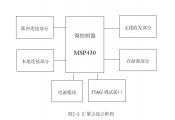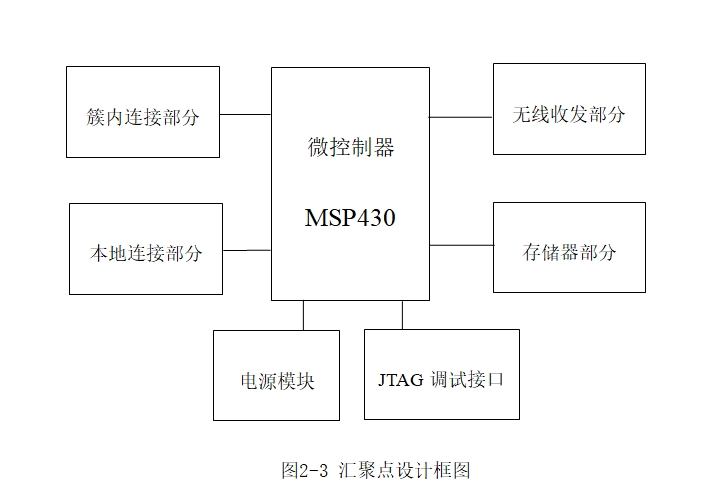基于MSP430的无线传感网络汇聚点设计

基于MSP430的无线传感网络汇聚点设计(任务书,开题报告,外文翻译,论文22000字)
摘 要
现代传感技术,计算机技术和无线通信技术的进步,推动了无线传感器网络的现代意义上的出现和发展。从硬件典型的无线传感器网络通常包括传感器节点,汇聚点(网关节点)和管理节点。其中,从所述汇聚点为每个传感器节点的数据融合,并负责与外部世界的通信,这是基于在嵌入式系统上实现。
本文以建立一个实用的无线传感器网络汇聚点为背景,深入研究了传感器网络的硬件设计原则与节能机制,采用高速数字电路设计原理与嵌入式系统设计流程,设计并实现了汇聚点。汇聚点是负责下行节点数据采集与数据包跳转的重要枢纽,数据交互量大,操作频繁;论文重点研究无线传感器网络的汇聚点设计与实现,在设计中追求低功耗,高集成的特点。要对无线传感器网络的工作原理进行研究,根据指定的MSP430系列低功耗微处理器,熟悉指定型号MCU的有关技术指标与使用方法。根据节点数量确定通讯网络拓扑结构,设计集中器或采集器负责传感器网络节点的管理(信号采集或收集),实现数据处理上传和网络管理等功能,这要求对无线传感器网络中汇聚点的特点和功能进行分析,汇聚点硬件设计以及软件设计,硬件设计中着重介绍MSP430处理器功能和硬件电路如何实现,软件电路中着重介绍软件工作和软件具体实现。制定无线传感网络自组织协议和命令下发制,编程实现采集器对下行节点数据收集和采集器间数据跳转等功能,并在硬件平台上调试。设计的系统是利用超低功耗单片机 MSP430的超低功耗使其在电池供电,便携式设备的应用中表现出非常优良的特性。同时该系统还使用了射频模块。单片机,射频模块以及其它相关的模块组合在一起做成端机与基站,文中是对之硬件的设计与软件的控制加以分析。 [资料来源:Doc163.com]
关键词:无线传感器网络 汇聚点 通讯协议 低功耗
MSP430-based wireless sensor network design focal point
Abstract
Modern sensor technology, computer technology and advances in wireless communications technology, and promote the emergence and development of a modern sense of wireless sensor networks. A typical wireless sensor network from the hardware typically includes sensor nodes, sink node (gateway node) and the management node. Among them, the sink node for data obtained from each sensor node fusion, and is responsible for communicating with the outside world, it is based on an embedded system to achieve.
In this paper, in order to establish a practical wireless sensor network aggregation nodes as the background , in-depth study of the hardware design principles and energy-saving mechanism sensor networks , high-speed digital circuit design theory and embedded system design process , design and implementation of a focal point . Focal point is an important hub for downstream nodes responsible for data collection and data packets jump , data exchange capacity, frequent operation ; focal point paper focuses on the design and implementation of wireless sensor networks in the pursuit of low -power design , high integration features . To the working principle of the wireless sensor network research , according to the specified MSP430 family of low- power microprocessor , familiar with the technical specifications and use the specified model of the MCU. According to the number of nodes to determine the management of communications network topology , design , or acquisition is responsible for centralized sensor network node ( signal acquisition or collection ) , data processing and network management features such as uploading , which requires the convergence of wireless sensor networks and point features function to analyze the convergence point hardware design and software design , hardware design focuses on how MSP430 processor features and hardware , software, circuits work focuses on software and software implementation. The mechanisms to develop self-organizing wireless sensor network protocol and command , programming acquisition of downstream nodes between data collection and data acquisition jumps and other functions, and debugging on the hardware platform. The system design is the use of ultra-low -power MSP430 ultra-low power microcontroller applications it in a battery -powered , portable devices exhibited very good characteristics. The system also uses the same radio frequency module. Microcontroller, RF module and other related modules together with the base to make ends , the text is the control of the hardware design and software analysis.
Key Words: Wireless sensor networks ; Aggregation node ; Communication protocol ; Low power consumption
[资料来源:Doc163.com]


目 录
摘 要 I
Abstract II
第一章 绪论 1
1.1 无线传感网络的研究背景及意义 1
1.2 国外无线传感网络的研究历程及发展趋势 2
1.3 国内无线传感网络的研究历程及发展趋势 4
1.4 论文研究的内容 5
1.5 论文的章节安排 6
第二章 汇聚点总体设计 8
2.1 汇聚点功能需求分析 8
2.2 汇聚点的设计方案 9
2.3 本章小结 10
第三章 汇聚点硬件的设计 11
3.1 MSP430系列单片机概述 11
3.2 主控芯片的选型 12
3.3 无线射频芯片的选型 15
3.4 JTAG接口电路 16
3.5 FLASH接口电路 17
3.6 SDRAM接口电路 17
3.7 汇聚点的PCB设计 18
3.8 本章小结 19
第四章 汇聚点的系统软件设计 20
4.1 开发环境 20
4.2 程序设计 21
4.2.1 主程序 21
4.2.2 MSP430内部初始化 22
4.2.3 休眠HAT模块 24
4.2.4 表头唤醒HAT无线模块 24
4.2.5 抄表数据上传 24
4.2.6 下发唤醒帧并重发抄表命令 25
4.2.7 EEPROM的读写 26
4.3 无线传感网络通信协议的设计 27 [资料来源:http://doc163.com]
4.3.1 握手与应答 28
4.3.2 超时控制 29
4.3.3 表头度数主动上传 29
4.4 低功耗问题研究 30
4.4.1 硬件结构的低功耗设计 30
4.4.2 软件的节能设计 31
4.5 本章小结 31
第五章 总结与展望 33
5.1 论文总结 33
5.2 下一步的工作 33
参考文献 35
致 谢 37
附录:UART命令处理函数 38 [来源:http://Doc163.com]
